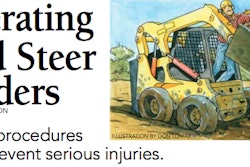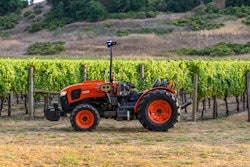Innovative alternative technology for your equipment
If you want to improve the fuel efficiency of your equipment, take a lesson from DeSantis Landscapes.
A discussion about environmental sustainability during the company’s annual strategic planning session in 2005 took an interesting turn, says Dean DeSantis, president and second-generation owner of the family-owned business in Salem and Oregon City, Oregon.
In addition to its longstanding commitment to natural landscaping practices, the company decided to focus on improving the environmental impact of its internal business operations, beginning with its fleet of vehicles and equipment. Since then, DeSantis has avoided using more than 61,285 gallons of petroleum fuel for its 38-vehicle fleet, reducing his company’s carbon dioxide emissions by more than a half-million pounds (a figure he reports is equivalent to taking 40 vehicles off of the road).
“It may seem risky at first, but the benefits to your community and your business are worth it.”
The company’s initiatives include switching to hybrid passenger cars and smaller fuel-efficient pickup trucks for management team members, as well as using biodiesel instead of petroleum diesel for trucks, tractors, large mowers and other large equipment.
DeSantis Landscape’s team sought better ways to incorporate sustainable practices into all aspects of the business.
“Our commitment to sustainability has become the foundation of our company,” DeSantis says. “It goes beyond our commitment to natural landscaping practices and into the day-to-day operations of our business.
Growing Options
There are a variety of ways you can make your company more fuel-efficient. To save money over the long run, the key is to select the best equipment and then maintain and operate it at peak efficiency.
With a push by manufacturers to offer more efficient equipment, there are more choices than ever. Here’s a roundup of some of the most notable new offerings that may prove to be trendsetters.
Diesel Mower Appeal
The Grasshopper Company, which makes both gas- and diesel-powered commercial mowers, has seen more landscapers turning to diesel recently for several reasons. “Grasshopper MaxTorque Clean Diesel mowers will consume about 0.9 gph in average conditions, versus a comparable gas model consuming 1.8 gph, and a propane equivalent consuming nearly 2 gph,” says Ray Garvey, Grasshopper product specialist. “On models with 8-gallon tanks, this means MaxTorque Clean Diesel mowers can operate a full work day without refueling, while gas and LP models will need refilling on average about every four to five hours.
MaxTorque Clean Diesel mowers can operate a full work day without refueling
Clean diesel draws many landscapers for economic reasons.
“Clean diesel packs almost 15 percent more power, drop for drop, than gasoline and almost 40 percent more power than LP,” Garvey says. “When harnessed properly, this power translates into faster job completion times and a 50 percent or more reduction in fuel consumption.”
While occasional sharp spikes in the cost of gasoline may push customers in the direction of diesel mowers, low emissions and long-term sustainability principles are driving even more lawn care operators to clean diesel equipment.
Chris Shipp, owner of Shipp Shape Lawn Service in Sylvester, Georgia, got his start in the green industry for more than 30 years with several gas-powered Grasshopper mowers, but later switched to diesel.
“Considering the cost of off-road diesel fuel versus on-road diesel fuel, plus the overall better fuel efficiency than gasoline, the switch to diesel made sense,” he says.
Shipp owns seven Grasshopper diesel mowers, a mixture of MidMount and FrontMount models. “Compared to our previous gasoline mowers, Shipp Shape saves roughly 1.25 gallons of fuel per hour per machine with diesel, which saves the company more than $13,000 a year – assuming we operated all gasoline instead of all diesel,” he says.
CASE STUDY: Diesel vs. Gas Mowers
.
Diesel-Electric Truck
Going one step further than the diesel engine, Hino Trucks, a Toyota Group Company, announced production of a diesel hybrid cab over engine truck (COE). At the 2011 NTEA Work Truck Show, Hino Trucks unveiled its Class 4 and 5 COE with the first U.S. diesel-electric hybrid offering. Headquartered in Novi, Michigan, Hino assembles, sells and services Class 4-7 commercial trucks. Their challenge was to meet strict emissions and fuel-efficiency guidelines affordably without compromising power and performance. In the Class 4 market, the revolutionary 155h (“h” is for hybrid) vehicle will carry a 14,500 -pound GVW rating. In the Class 5 market, Hino’s 195h model will carry a 19,500-pound GVW rating.
“In a city route application, a diesel hybrid truck can achieve as much as 40 to 50 percent better fuel economy than a gas engine.”
“Hino Trucks is making the diesel-electric hybrid a viable option in the U.S. commercial truck industry,” says Sumio Fukaya, president and CEO of Hino Trucks. Adding to its fuel efficiency is the cab’s design, which emphasizes aerodynamics and visibility with an angled windshield, narrow pillars and rounded-radius curves. A crew cab version will also be available.
Hino’s pioneering diesel-hybrid cab over engine truck
The price of the new hybrids will be competitive with other COEs in the Class 4 and 5 markets, says Glenn Ellis, vice president of marketing and dealer operations for Hino. “What we have seen in our internal testing is the 2010 EPA hybrid configuration, in city routes where the vehicle averages less than 20 mph, can achieve a 30-percent fuel economy improvement over a comparable 2007 EPA diesel engine,” he says. “In a city route application, a diesel-hybrid truck can achieve as much as 40 to 50 percent better fuel economy than a gas engine.
Propane Power
Propane-powered Husqvarna PZ ZTR
“There are more than 15 models of propane-fueled commercial lawn mowers offered from industry-leading brands,” says Brian Feehan, vice president, Propane Education and Research Council (PERC). “Commercial propane-fueled mowers typically hold one to two fuel cylinders for a combined fuel capacity of up to about 15 gallons.
“Propane-fueled hand-held equipment is also available,” notes Feehan.
While propane does not run equipment as efficiently as gasoline or diesel, its overall fuel efficiency comes from lower, more stable pricing.
Roush CleanTech, which manufactures vehicles fueled by propane autogas, reports a 15-percent loss in fuel economy across all vehicle applications due to a lower BTU rating of propane autogas compared to gasoline. But Roush also notes propane autogas is on average 30 to 40 percent less expensive than gasoline.
Propane providers are also catering to landscapers. “Offering fuel delivery options to landscape companies is a key growth strategy for propane providers in the United States,” Feehan says.
FUEL SAVING TIPS
To improve fuel economy and reduce our impact on the environment, the simplest things can make a difference. Smarter driving and maintenance are two steps everyone can take. Among those suggested by Enterprise Fleet Management are the following:
• Keep engines tuned. A tune-up in- creases fuel economy. Check for worn spark plugs, dragging brakes and low transmission fluid. Have wheels aligned and tires rotated and replace air filters if needed.
• Replace older, less fuel-efficient vehicles at appropriate intervals. Knowing when to dispose of older vehicles, “cycling,” depends on many factors, such as the time of year, mileage, vehicle type, age and maintenance issues.
• Lighten your load. The more weight a vehicle carries, the lower its fuel economy. This is especially true for light-duty trucks, which can feature the same space dimensions but vary significantly in gross vehicle weight rating (GVWR), towing or payload capacity and other options.
• Keep tires properly inflated. Under-inflated tires create more rolling resistance on the road, which decreases gas mileage and shortens tire life due to improper wear.
• Select the right oil for your engine. Higher-viscosity oils create greater resistance to moving parts of the engine and require more gas.
Changing oil every 3,000 to 5,000 miles is a good maintenance policy and also improves fuel efficiency.










